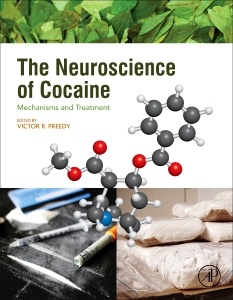Description
The Neuroscience of Cocaine
Mechanisms and Treatment
Coordinator: Preedy Victor R
Language: English
Subjects for The Neuroscience of Cocaine:
Keywords
11CABP688; 5-HT1B receptor; ADHD; ADME; AMPA; AP-1; Abuse; Acamprosate; Acetylation; Acetylcholine; Acid-sensing ion channels; Acquisition; Addiction; Addiction therapy; Adenosine; Adolescent; Adulterant; Agonist; Alcohol; Ambivalence; Aminorex; Analysis; Anatomical pathway; Animal models of addiction; Antagonist; Antipsychotics; Anxiety; Apoptosis; Appetite; Argonaute protein; Attention deficit hyperactivity disorder; Attentional bias; Atypical antipsychotics; Aversion; BDNF; Basal ganglia; Bed nucleus of the stria terminalis; Behavior; Behavioral sensitization; Bioenergetics; Bioinformatics; Biperiden; Blood; Blood concentrations; Books; Brain; Brain-derived neurotrophic factor; Brief intervention; Butyrylcholinesterase; CB2 receptor; CRF; Cannabinoid; Cannabis; Cell type-specific; Chromatography; Circadian rhythm; Clinical; Clinical comorbidities; Cluster headache; Cocaine; Cocaine addiction; Cocaine aversion; Cocaine deaths; Cocaine dependence; Cocaine hydrolase; Cocaine reward; Cocaine use disorder (CUD); Cocaine-induced disorders; Cocaine-induced headache; Cognition; Cognitive control; Cognitive function; Computational docking; Conditioned place preference; Conditioned stimuli; Corticosterone; Cortisol; Crack; Crack cocaine; Craving; D-serine; DNA binding domain; DNA demethylation; DNA methylation; DNA methyltransferase; Decision-making; Delay-discounting; Delta opioid receptor; DeltaFOSB; Demand; Disulfiram; Dopamine; Dopamine receptor; Dopamine receptors; Dopamine transporter; Dopaminergic differentiation; Dorsolateral striatum; Dorsomedial striatum; Drd1a-EGFP mice; Drug
Support: Print on demand
Description
/li>Contents
/li>Readership
/li>Biography
/li>Comment
/li>
The Neuroscience of Cocaine: Mechanisms and Treatment explores the complex effects of this drug, addressing the neurobiology behind cocaine use and the psychosocial and behavioral factors that impact cocaine use and abuse. This book provides researchers with an up-to-date understanding of the mechanisms behind cocaine use, and aids them in deriving new pharmacological compounds and therapeutic regimens to treat dependency and withdrawal symptoms.
Cocaine is one of the most highly abused illicit drugs worldwide and is frequently associated with other forms of drug addiction and misuse, but researchers are still struggling to understand cocaine?s neuropharmacological profile and the mechanisms of its effects and manifestations at the cognitive level. Cessation of cocaine use can lead to numerous adverse withdrawal conditions, from the cellular and molecular level to the behavioral level of the individual user. Written by worldwide experts in cocaine addiction, this book assists neuroscientists and other addiction researchers in unraveling the many complex facets of cocaine use and abuse.
Part 2. Effects of Cocaine Misuse on Neurological Function and Features
Part 3. Pharmacology and Neuropharmacology
Part 4. Withdrawal and Abstinence
Part 5. Cocaine as a Component of Dual-Use and Polydrug Use or Poly Addictions
Part 6. Cellular Effects and Molecular Biology of Cocaine
Part 7. Treatments for Cocaine Misuse and Dependency and Related Features
- Contains in each chapter an abstract, key facts, mini dictionary of terms, and summary points to aid in understanding
- Illustrated in full color
- Provides unique full coverage of all aspects of cocaine and its related pathology
- Provides researchers with an up-to-date understanding of the mechanisms behind cocaine use, and aids them in deriving new pharmacological compounds and therapeutic regimens to treat dependency and withdrawal symptoms




